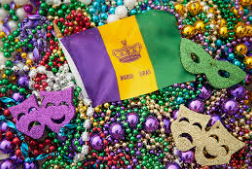
Mardi Gras, or “Fat Tuesday” in French, is a lively celebration that takes place before Lent, a Christian season of fasting. While it is celebrated in many places New Orleans and Louisiana are known for having the biggest and most famous Mardi Gras festivals, that include parades, music, and colorful costumes.
The holiday has its roots in ancient European traditions, where people enjoyed feasts before giving up certain foods for Lent. When French explorers arrived in Louisiana in the late 1600s, they brought Mardi Gras with them. Over time, the celebrations in New Orleans grew, adding parades, masquerade balls, and other festive events. Today, Mardi Gras attracts millions of visitors who come to experience the excitement. One of the highlights main of Mardi Gras is the parades, organized by groups called krewes. These krewes create elaborate floats and wear masks and costumes while tossing beads, coins called doubloons, and small trinkets or toys to the people in the crowds. People often dress in purple, green, and gold—the official Mardi Gras colors, that represent justice, faith, and power. Another well-known tradition is the King Cake, a round, sweet pastry decorated with icing and sprinkles in Mardi Gras colors. A small plastic baby is hidden inside, and whoever finds it is expected to host the next party.
However, Mardi Gras is more than just a party—it’s a cultural tradition that brings people together to celebrate creativity, community, and joy. Whether watching a parade, catching beads, or enjoying a slice of King Cake, Mardi Gras is a time for fun and excitement that people of all ages can enjoy.